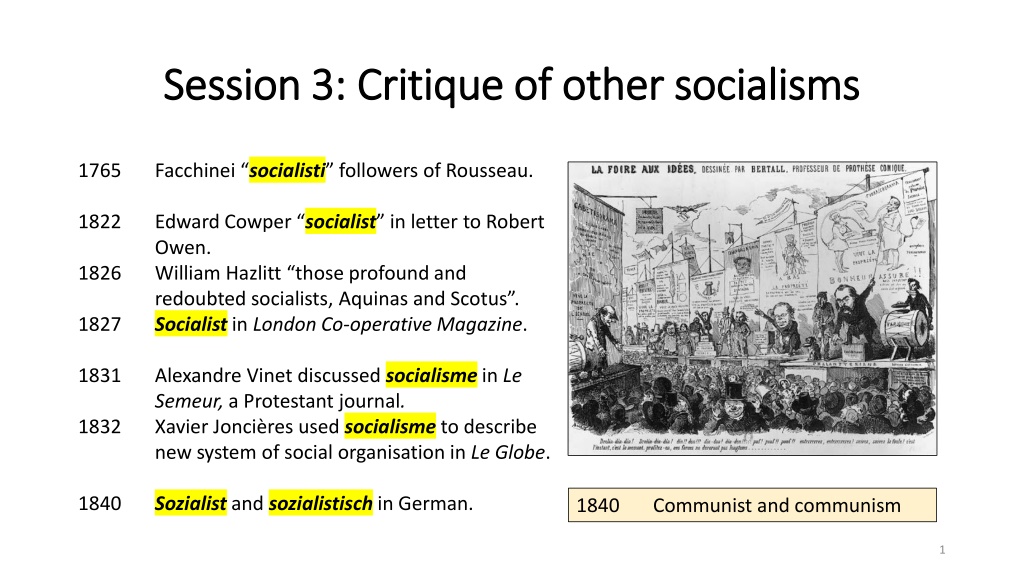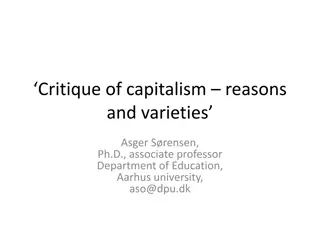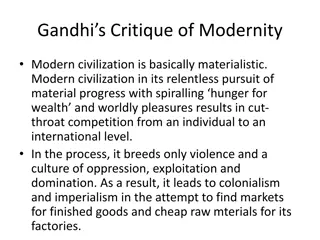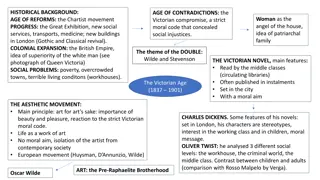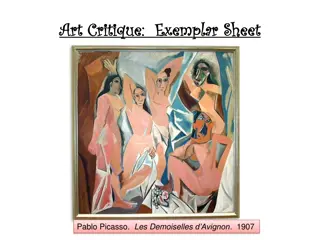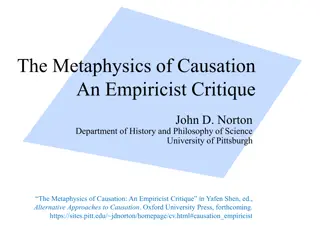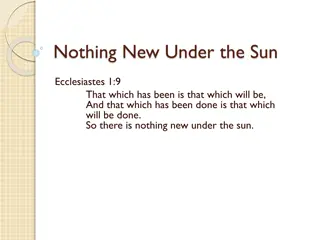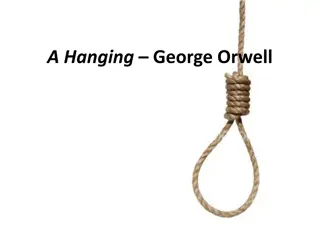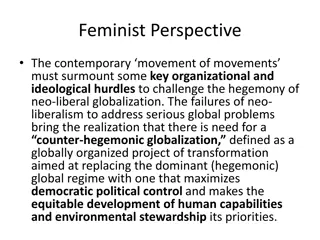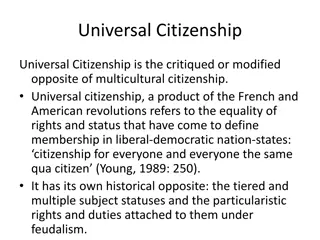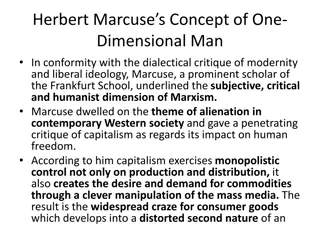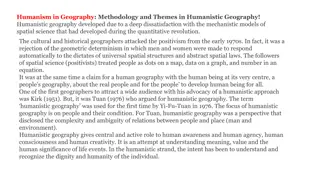Critique of Various Socialisms Throughout History
Critique various socialisms from history - including feudal socialism, petty-bourgeois socialism, and German or True Socialism. Discusses the origins, criticisms, and impact of these ideologies on societal structures and historical movements.
Download Presentation

Please find below an Image/Link to download the presentation.
The content on the website is provided AS IS for your information and personal use only. It may not be sold, licensed, or shared on other websites without obtaining consent from the author. Download presentation by click this link. If you encounter any issues during the download, it is possible that the publisher has removed the file from their server.
E N D
Presentation Transcript
Session 3: Critique of other socialisms Session 3: Critique of other socialisms 1765 Facchinei socialisti followers of Rousseau. 1822 Edward Cowper socialist in letter to Robert Owen. William Hazlitt those profound and redoubted socialists, Aquinas and Scotus . Socialist in London Co-operative Magazine. 1826 1827 1831 Alexandre Vinet discussed socialisme in Le Semeur, a Protestant journal. Xavier Jonci res used socialisme to describe new system of social organisation in Le Globe. 1832 1840 Sozialist and sozialistisch in German. 1840 Communist and communism 1
1a. Reactionary: feudal socialism 1a. Reactionary: feudal socialism Thomas More, Utopia (1551) Tommaso Campanella, The City of the Sun (1623) Feudal Socialism: half lamentation, half lampoon; half an echo of the past, half menace of the future; at times, by its bitter, witty and incisive criticism, striking the bourgeoisie to the very heart s core; but always ludicrous in its effect, through total incapacity to comprehend the march of modern history. Nothing is easier than to give Christian asceticism a socialist tinge Christian socialism is but the holy water with which the priest consecrates the heart-burnings of the aristocrat. 2
1b. Reactionary: petty 1b. Reactionary: petty- -bourgeois socialism bourgeois socialism In countries like France, where the peasants constitute far more than half of the population, it was natural that writers who sided with the proletariat against the bourgeoisie should use, in their criticism of the bourgeois r gime, the standard of the peasant and petty bourgeois, and from the standpoint of these intermediate classes, should take up the cudgels for the working class. Thus arose petty-bourgeois Socialism. Sismondi was the head of this school, not only in France but also in England. In its positive aims, however, this form of socialism aspires either to restoring the old means of production and of exchange, and with them the old property relations, and the old society, or to cramping the modern means of production and of exchange within the framework of the old property relations that have been, and were bound to be, exploded by those means. In either case, it is both reactionary and utopian. 3
1c. Reactionary: German or True Socialism 1c. Reactionary: German or True Socialism By this, the long-wished for opportunity was offered to True Socialism of confronting the political movement with the socialist demands, of hurling the traditional anathemas against liberalism, against representative government, against bourgeois competition, bourgeois freedom of the press, bourgeois legislation, bourgeois liberty and equality, and of preaching to the masses that they had nothing to gain, and everything to lose, by this bourgeois movement. While this True Socialism thus served the government as a weapon for fighting the German bourgeoisie, it, at the same time, directly represented a reactionary interest, the interest of German Philistines. In Germany, the petty-bourgeois class, a relic of the sixteenth century, and since then constantly cropping up again under the various forms, is the real social basis of the existing state of things. 4
2. Conservative or Bourgeois Socialism 2. Conservative or Bourgeois Socialism To this section belong economists, philanthropists, humanitarians, improvers of the condition of the working class, organisers of charity, members of societies for the prevention of cruelty to animals, temperance fanatics, hole-and-corner reformers of every imaginable kind We may cite Proudhon s Philosophie de la Mis re as an example of this form. It but requires in reality, that the proletariat should remain within the bounds of existing society administrative reforms, based on the continued existence of these relations; reforms, therefore, that in no respect affect the relations between capital and labour, but, at the best, lessen the cost, and simplify the administrative work, of bourgeois government. 5
3a. Critical 3a. Critical- -Utopian Socialism: Forerunners Utopian Socialism: Forerunners The Socialist and Communist systems, properly so called, those of Saint-Simon, Fourier, Owen, and others The most direct way to bring about an improvement in the moral and physical well-being of the majority of the population is to give priority in state expenditure to the provision of work for all fit men, so as to assure their physical existence; to disseminate as quickly as possible among the proletarian class the positive knowledge which has been acquired; and to ensure that the individuals composing this class have forms of leisure and interests which will develop their intelligence. Saint-Simon, Fragments on Social Organisation (1825) Social progress and changes of historical period take place in proportion to the advance of women toward liberty, and social decline occurs as a result of the diminution of the liberty of women... The extension of the privileges of women is the fundamental cause of all social progress. Fourier, The Theory of the Four Movements (1808) 6
3b. Critical 3b. Critical- -Utopian Socialism: Saint Utopian Socialism: Saint- -Simonians Simonians The exploitation of man by his fellows, whatever its origin may be, is the most characteristic phenomenon of the past Men may then be divided into two classes, the exploiters and the exploited At last the exploitation of man by man, which we have shown in its most direct and uncouth form in the past, namely slavery, continues to a very large extent in the relations between owners and workers, masters and wage earners. Of course, the respective conditions of the classes today are far from those of masters and slaves, patricians and plebeians, or lords and serfs in the past... If the exploitation of man by man no longer has the brutal character of antiquity and assumes more gentle forms today, it is, nevertheless, no less real The exploitation of man by man must disappear. The constitution of property which is hereby perpetuated must, therefore, also disappear The doctrine of Saint-Simon does not want to bring about an upheaval or a revolution through slow and successive transformation peaceful and gradual. Bazard and Enfantin (1828-29) The Doctrine of Saint-Simon (1828-29) 7
3c. Critical 3c. Critical- -Utopian Socialism: Fourierists Utopian Socialism: Fourierists Society tends to be divided more and more sharply into two major classes The desperate struggles of bosses against workers, of workers against bosses, of each against all and of all against each, are not inevitable conditions of human existence. Victor Consid rant, Manifeste de la d mocratie pacifique (1843) We are not communists. We believe that the principle of individual property is a right, a sacred right, without which there can be no lasting and stable society. Victor Consid rant, Pour en finir avec M. Cabet (1846) [King Louis Philippe] laying the first stone of the first Phalanstery . Victor Consid rant, Destin e sociale, Dedication, 2nd edition (1847) 8
Socialist feminism Socialist feminism Saint-Simonian women constituted themselves into a separate section in the movement in 1829, and took the initiative in running evening classes for artisans. Their leader was Claire Bazard and Eug nie Niboyet also took a leading role. Several dynamic young seamstresses attended their classes and became important in the movement, notably Marie-Reine Guindorf, D sir e V ret and Jeanne Deroin In 1829 the women s section in Paris had 200 regular members and groups developed in provincial cities, notably Lyon and Nantes V ret and Guindorf started a tiny newspaper for women, La Femme Libre, in August 1832 The paper survived until February 1834, appearing irregularly, 32 times in all; 1,000 copies of the first issue were printed Pamela Pilbeam, French Socialists before Marx (2000) 9
Flora Tristan Flora Tristan Workers Now the day has come when one must act, and it is up to you and only you to act in the interest of your own cause So leave your isolation: unite! Unity gives strength. You have numbers going for you, and numbers are significant. I come to you to propose a general union among working men and women, regardless of trade, who reside in the same region a union which would have as its goal the consolidation of the working class I am not a revolutionary or an anarchist or a bloodthirsty person Yes, I ask that the working class be unified in one body and have representation in the Chamber a measure in favour of order To ask for a defender for the working class is to want to replace the anonymous charlatans by a well-known university doctor Tristan, The Workers Union (1843) 10
Gracchus Babeuf Gracchus Babeuf A republic where the immense majority is in command and is sovereign; where every citizen enjoys the same rights; where we don't see unbridled luxury insulting the most terrible poverty; from which penury and corruption are banished; where every member of society can rely on subsistence, independently of the whims of fortune or of any individual; where virtue is honoured and crime punished; where in short true equality reigns, that is, common happiness. Babeuf, Le Eclaireur, No.4 (1895) Nobody can, without committing a crime, exclusively expropriate the goods of the earth or of industry. Unhappiness and slavery flow from inequality, and the latter from property. Property is thus the greatest of society s plagues. It is a veritable public offence. Analysis of the Doctrine of Babeuf. Flypost (April 1796) 11
Louis Louis- -August Blanqui August Blanqui Yes, gentlemen, this is the war between rich and poor: the rich wanted it so, for they are the aggressors. And yet they think it wrong that the poor resist. Blanqui, Defence Speech at the Trial (12 January 1832) In a word, we are always and everywhere with the oppressed against the oppressors... It makes no difference if oppression takes the form of military or commercial aristocracy, or if the people are exploited by the sabre or the coin; our hearts are moved with the same pity for the sufferings of the peasant trampled by his master s steed as for the agony of the worker whose blood serves to oil the gears of his industrial overlord. Blanqui Equality Is Our Flag (2 February 1834) 12
Communist League Communist League 1834 1836 1838 1846 1847 League of the Outlawed (Bund der Ge chteten) founded. Members of League of the Outlawed formed League of the Just (Bund der Gerechten). The League of the Just commissioned Weitling sMankind As It Is and As It Ought To Be. League reply to Marx s letter, 6 June 1846, for communication among communists Moll to Brussels, 20 January 1847 to encourage Marx and Engels to join the League. League of the Just convened its first international congress in London from 2 to 9 June 1847. Name changed to Communist League (Bund der Kommunisten). Adopted the new slogan Workers of all Countries, Unite! (Proletarier aller Lander vereinigt Euch!) Kommunistische Zeitschrift, newspaper of the Communist League, September 1847. Second congress of the Communist League, London, 29 November to 10 December 1847. Rules Article 1: The aim of the League is the overthrow of the bourgeoisie, the rule of the proletariat, the abolition of the old bourgeois society which rests on the antagonism of classes, and the foundation of a new society without classes and without private property. 13
Discussion Discussion Questions Concepts 1) What is the defining feature of reactionary socialism? 2) What is the defining feature of bourgeois socialism? 3) What is the defining feature of utopian socialism? 4) Discuss modern examples of: reactionary socialism; bourgeois socialism and utopian socialism. 5) Is this division of socialists useful? 6) What other ways of evaluating forms of socialism are there? 7) Which other Communists doesn t Marx criticise in the Manifesto? Why? Reactionary socialism Bourgeois socialism Utopian socialism Saint-Simonian Fourierist Owenite Socialism from above and below Communists 14
